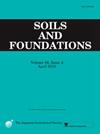Effects of internal erosion on mechanical properties of different soil compositions and its impact on their cyclic response
IF 3.3
2区 工程技术
Q2 ENGINEERING, GEOLOGICAL
引用次数: 0
Abstract
Suffusion, a process whereby water gradually carries away fine particles from soil, is thought to be one of the possible reasons for the settlement or inclination of bridge piers after a major flood (delayed displacement). The aim of this study is to offer fresh insights into suffusion and its mechanical impact on the affected soil, with a specific focus on how it relates to bridge pier failures. Riverbed material is replicated with relatively larger fine particles than those used in past studies which focused on soil in embankments or dikes.
Through both monotonic and cyclic loading tests on soil samples with varying initial fines contents, while maintaining a constant relative density of 79%, several important discoveries are made. The small strain stiffness of suffused soil fluctuates as erosion occurs, along with a decrease in shear strength and an increase in soil contraction under monotonic stress. Furthermore, the research simulates the train loading exerted on the base soil of bridge piers susceptible to suffusion by subjecting the soil samples to cyclic loading both before and after erosion, mirroring practical conditions. The key findings of this study reveal that the stiffness of soil drops during erosion with no significant deformation of the soil. This leads to a large strain accumulation in the soil specimens under subsequent cyclic traffic loading. These findings highlight that the delayed settlement or inclination of bridge piers under cyclic or train loading after a major flood is possibly due to suffusion in the base soil of the piers.
内侵蚀对不同土壤成分力学特性的影响及其循环响应
水逐渐从土壤中带走细颗粒的过程被认为是大洪水后桥墩沉降或倾斜的可能原因之一(延迟位移)。本研究的目的是为渗透及其对受影响土壤的机械影响提供新的见解,并特别关注它与桥梁桥墩破坏的关系。与过去着重于堤防土壤的研究相比,用相对较大的细颗粒复制河床材料。在相对密度恒定为79%的情况下,对不同初始细粒含量的土样进行了单调加载和循环加载试验,得到了一些重要发现。浸润土的小应变刚度随侵蚀的发生而波动,单调应力作用下土体抗剪强度减小,收缩增大。此外,通过对易发生渗水的桥墩基础土进行侵蚀前和侵蚀后的循环加载,模拟列车荷载作用于易发生渗水的桥墩基础土,以反映实际情况。本研究的主要发现是土壤在侵蚀过程中刚度下降,但土壤没有明显的变形。这导致土样在后续循环交通荷载作用下产生较大的应变积累。这些研究结果表明,大洪水后桥墩在循环或火车荷载作用下的延迟沉降或倾斜可能是由于桥墩基础土的渗透造成的。
本文章由计算机程序翻译,如有差异,请以英文原文为准。
求助全文
约1分钟内获得全文
求助全文
来源期刊

Soils and Foundations
工程技术-地球科学综合
CiteScore
6.40
自引率
8.10%
发文量
99
审稿时长
5 months
期刊介绍:
Soils and Foundations is one of the leading journals in the field of soil mechanics and geotechnical engineering. It is the official journal of the Japanese Geotechnical Society (JGS)., The journal publishes a variety of original research paper, technical reports, technical notes, as well as the state-of-the-art reports upon invitation by the Editor, in the fields of soil and rock mechanics, geotechnical engineering, and environmental geotechnics. Since the publication of Volume 1, No.1 issue in June 1960, Soils and Foundations will celebrate the 60th anniversary in the year of 2020.
Soils and Foundations welcomes theoretical as well as practical work associated with the aforementioned field(s). Case studies that describe the original and interdisciplinary work applicable to geotechnical engineering are particularly encouraged. Discussions to each of the published articles are also welcomed in order to provide an avenue in which opinions of peers may be fed back or exchanged. In providing latest expertise on a specific topic, one issue out of six per year on average was allocated to include selected papers from the International Symposia which were held in Japan as well as overseas.
 求助内容:
求助内容: 应助结果提醒方式:
应助结果提醒方式:


